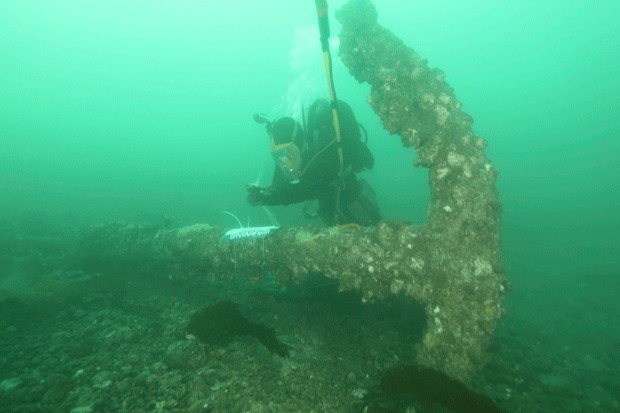If it’s what a team of treasure hunters hope, an artifact connected with the Pacific Northwest’s most famous European explorer will leave the seafloor for the first time in over two centuries next week.
State regulators have issued Anchor Ventures, LLC, a permit to raise an anchor they believe was lost during Captain George Vancouver’s legendary exploration of Puget Sound in the early 1790s.
The plan is to raise the 1,000-pound relic from shallow water in Admiralty Inlet on Monday, a date team members say holds special significance.
“June 9 is 222 years to the day [the anchor was lost],” said Scott Grimm, a Seattle resident and member of the team.
The recovery is the culmination of years of work by Grimm and Doug Monk, a Port Angeles commercial diver and boat owner who found the anchor while diving in 2008. Just where it came from is a matter of some dispute, but research has led them to strongly believe it’s the fabled stream anchor lost from the HMS Chatham [pronounced chat-uhm] on June 9, 1792, the 80-foot survey brig that accompanied Vancouver on the HMS Discovery.
“I think everyone on the team is fairly confident,” said Monk, though he added they are hoping for a bit of visual evidence, such as a royal navy embossment on the shank.
That can only happen, however, once the anchor is recovered and restored, and local history lovers say that can’t happen soon enough.
“I’m trying not to get too excited,” said Rick Castellano, director of the Island County Historical Society.
The Chatham’s missing anchor is a “priceless artifact,” and if this is the same artifact, it will be a physical link connecting Washington and Whidbey Island with a famous period of history.
“I want to see it; show me the anchor,” Castellano laughed.
According to Grimm, once raised, the artifact will be transported to the Northwest Maritime Center in Port Townsend, where it will be displayed for several weeks in a saltwater tank. From there it’s to be trucked to Texas A&M University for conservation and stabilization, a process that will take several years.
According to James Delgado, director of the National Oceanic and Atmospheric Administration’s Marine Heritage Program for National Marine Sanctuaries, Anchor Ventures has amassed a “fair body of circumstantial evidence,” but the real proof of the anchor’s origins will be found at Texas A&M University.
“Ultimately, all science comes down to what’s found in the lab,” Delgado said.
But even if the restoration shows the anchor was not from the Chatham, it’s still a valuable artifact with a story from an early period of Washington’s history.
“The mystery then deepens, if you will,” Delgado said.
It’s unclear what will happen once the anchor is restored. The team’s permit with the state Department of Archeology and Historic Preservation requires only that Anchor Ventures “make reasonable efforts” to place it in a “suitable establishment” in Washington within five years. Monk and Grimm want to recover their expenses, but both hope that it will end up in the region.
“My preference is here,” said Monk, though he added that he believes Canada has just as much right to the artifact as the U.S.
The British government also has a claim on the anchor, Monk said. Anchor Ventures is the legal owner in the U.S., but England could claim “sovereignty” which would trump their claim.
The fate of the anchor won’t be decided for years to come, however, and Monk said his thoughts are focused now on next week’s recovery operation.
Experts are required to be on hand for the effort, per the state’s permit, but Monk has the honor of personally connecting the artifact to a barge-mounted crane.
“I get to hook it up and watch it lifted from the bottom,” he said. “That’s probably the best part of the whole thing.”
The operation will be hard to miss from shore, consisting of a flotilla of vessels — a barge and crane, at least three large passenger boats ferrying journalists and a documentary film crew, and a run-about. Grimm said it may be a bit of a circus and requested curious boaters to keep their distance as a matter of safety.
The operation should commence at about 1 p.m. Monday, and the public is welcome and encouraged to observe the event from locations on shore. In fact, it something people should not miss.
“It’s a once-in-a-lifetime thing,” Monk said.



